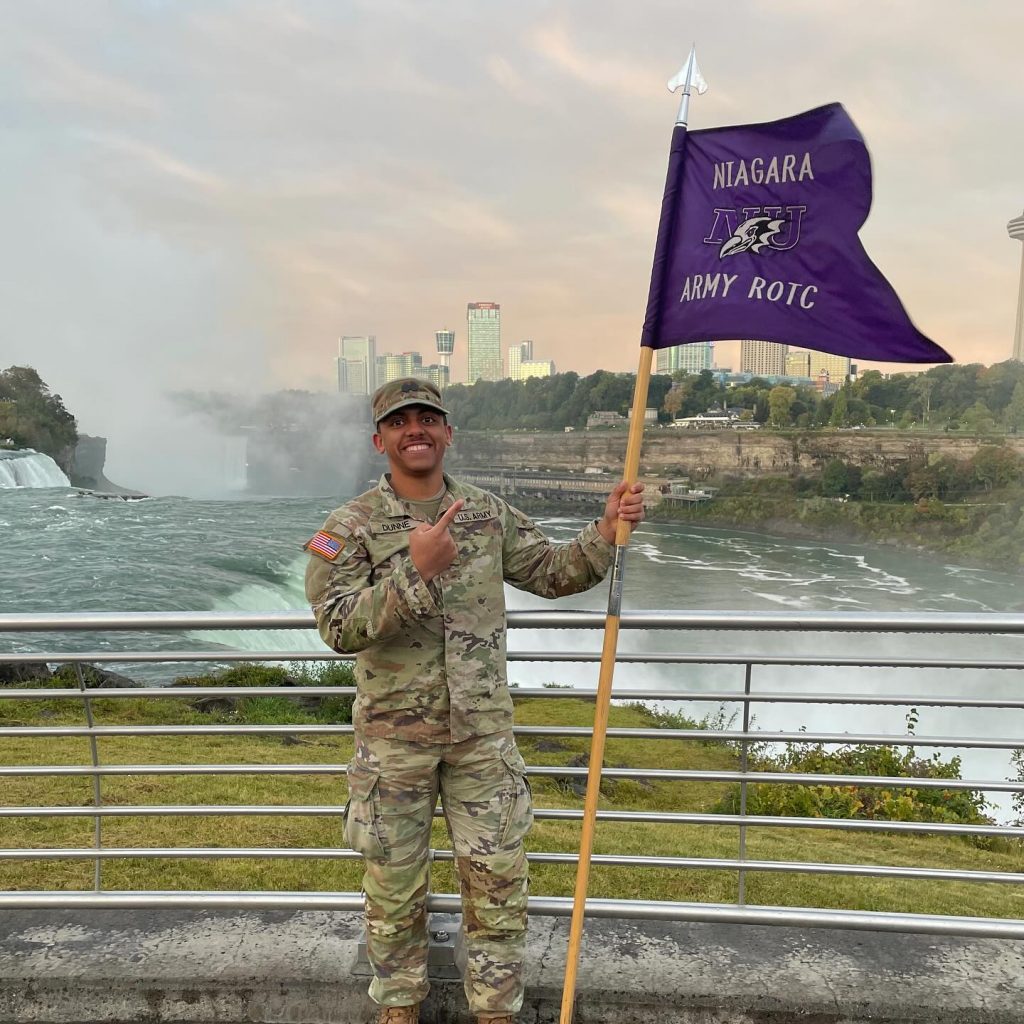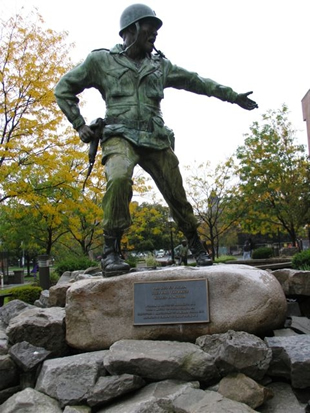
World War I Era
Within one month of the U.S. entry into World War I, the University sent a letter to the President of the United States “affirming the patriotism and allegiance of the residents of the Ridge.” In response to a state law mandating weekly drills, military training was officially ratified by the faculty and incorporated into the collegiate curriculum. By 1917, the entire male student body participated in drills, sometimes for as much as 10 hours per week, under the informal supervision of a Drill Sergeant from the then-active Fort Niagara. In early 1918, Fr. Joseph M. Noonan, C.M., organized the Student Army Training Corps (S.A.T.C.), which, with a strength of about 200, was barracked together in Alumni Hall. The entire student body continued drilling under the direction of two Lieutenants from Fort Niagara and selected Cadet officers. The quasi-military organizations of 1917-18, while not fully adhering to official Army regulations, marked Niagara University’s first direct involvement in military activities and played a significant role in the history of the institution’s connection to national defense efforts.

Establishment of the Reserve Officers' Training Corps at Niagara
Formal application for the establishment of a senior unit of the Reserve Officers’ Training Corps at Niagara was made to the War Department by the Very Reverend Joseph M. Noonan, C.M., President of the University, in October, 1935. Initial plans called for the initiation of a motorized Field Artillery unit. Representatives from the War Department, after a tour of the campus, came to the conclusion that Niagara’s location, terrain, and proximity to Fort Niagara were suited for such a unit. The first commissioned Niagara ROTC class began in April of 1936 and graduated sixteen cadets in 1940. No Cadets were given their commissions at Niagara’s Commencement Ceremonies for the years 1943-1947. As the task of procuring officers was temporarily transferred from ROTC to Officer Candidate Schools, ROTC was more and more phased from Niagara’s curriculum… leaving just the two-year basic course. Of the Niagara Cadets completing the two-year Basic Course who went on to enter the services, 69 percent were subsequently commissioned.
Honoring History: The Re-establishment of ROTC
In March 1945, Major Frederich A. Tillman was assigned to Niagara as Commandant of the 1288th SCE-ACER, an Army Air Corps unit which prepared future pilots for flying school. In that same month, Major Tillman received orders disbanding the 1288th and was instructed to direct his efforts towards re-institution of the Advanced Course. The commissions of 1948 are a result of the re-instituted Advance Course. With the advent of the Cold War, ROTC again became an important institution on campus. During the Korean War, between 50-90 Cadets were commissioned annually.
The Vietnam Era
The ROTC program continued largely unchanged commissioning 30-50 Cadets annually. In 1966, after two years of debate and some amount of student protest, participation in the Basic Course was made voluntary upon completion of the Spring of 1969. Although there was a notable drop in enrollment during these years, the Corps saw its first female Cadets in the Fall of 1973, with the College of Nursing beginning to make a significant contribution to the Corps of Cadets.
Niagara ROTC in the 80s and 90s
Enrollment in the ROTC program in the 1980 varied from 100 to 180, with the number of commissionees ranging from 13 to 24. The program drew from all segments of the University, with females comprising an important segment of the Corps. The program enjoyed widespread acceptance among the student body and support from the faculty and administration. In the 1990’s, enrollment declined and the program was realigned as a partnership school of Canisius College in Buffalo, New York.
Niagara ROTC now - the 21st Century
In 1999-2000, under the leadership of LTC John Hammill, Niagara University left Canisius College and re-established its own program. In 2002, Niagara University closed its nursing program, ending NU’s legacy of commissioning fantastic Army Nurses. For the last five years, Niagara has been ranked in the top 10% of Army ROTC programs in the United States (of 272 programs). In 2004, Niagara ranked # 1 nationally – proving that a small school in Western New York can compete with any program, anywhere. Although Cadet Command no longer nationally ranks, currently, Niagara’s program is listed as one of the top 14 schools in the nation.
